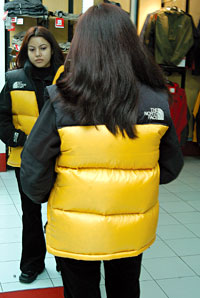 Today's Nepali motorcyclist is less interested in looking cool than keeping out the cold judging by those bulky down jackets many of them sport. And one label seems to have corned the market on winter wear: The North Face.
Today's Nepali motorcyclist is less interested in looking cool than keeping out the cold judging by those bulky down jackets many of them sport. And one label seems to have corned the market on winter wear: The North Face.
The outdoor product maker was born in 1966 and the name The North Face eventually chosen because the north face of a mountain, most notably Chomolungma, is considered the steepest, coldest, and most difficult to route to climb. But in the shops of Nepal you can say that this international brand wears two faces: the original North Face products and their cheaper imitations.
Despite Nepal's attraction for trekkers and climbers, original North Face products only arrived here in September of 2003. Recognising the widespread availability of counterfeit goods sporting the label and with increasing demand from Nepalis for high-end products, a showroom was set up at Durbar Marg, which later moved to Tridevi Marg in Thamel. Initially, it offered basic trekking gear, tents, axes, shoes and wind breakers. Today, the showroom also sells casual wear such as shirts and jeans for teenagers as North Face looks to widen its market beyond foreign trekkers, Sherpas and hotels.
"We want to target every group, from teenagers to trekkers to everyday Nepalis," says manager Sabina Sakya. The shop buys its goods from factories in Bangladesh and distributors in Korea, who also monitor quality. "We can guarantee high-end products and the quality of our goods," adds Sakya. The North Face showroom is making a large profit and expanding its space in Thamel and Sakya plans to open showrooms in Pokhara and other prime trekking destinations. Business is so good, in fact, that North Face offers sales twice a year, with discounts of up to 70 percent.
Meanwhile, in countless outdoor wear shops deep in the narrow, busy streets of Thamel, North Face is ubiquitous, shops offering what look to be the same products but at much lower prices. Here the price of a fleece jacket ranges from Rs 500 to Rs 1,500. These knockoff North Faces are now even seen on Maoist field commanders in the mountains.
Smadn Girel of Dolkha moved to Kathmandu eight years ago and is now settled in his own trekking shop. He lays out a number of gloves, glasses and jackets on his table, all of them brandishing the words The North Face. He picks up socks neatly packed in a plastic box that bears the picture of a climber with the silhouette of the sun behind him, looking uncannily like the package at the North Face showroom.
"North Face sells these socks for Rs 1,200, I sell it for Rs 200," he says. "They also get their products from China- they just charge more."
Girel says that unlike the showroom, he caters to people who cannot afford original prices. Many shopkeepers like him also run small factories that make jackets, gloves and socks, one reason why their clothing is so cheap.
They simply stitch on the North Face logo afterwards. These goods are also sold wholesale to smaller trekking shops. Heavy equipment such as axes, shovels and tents are imported from China. But these days Girel has too much free time. "No tourists, no trekkers, no business," he says forcing a smile.
Despite their competition, neither Sakya nor Girel show any signs of dislike for one another. "They sell what they need to in order to make a good living and I respect that. It would just be so much better if The North Face would start a factory in Nepal," says Sakya. Girel, for his part, is resolute, "I still get my customers when times are good. The showroom has had no effect on me or sales," he says.


